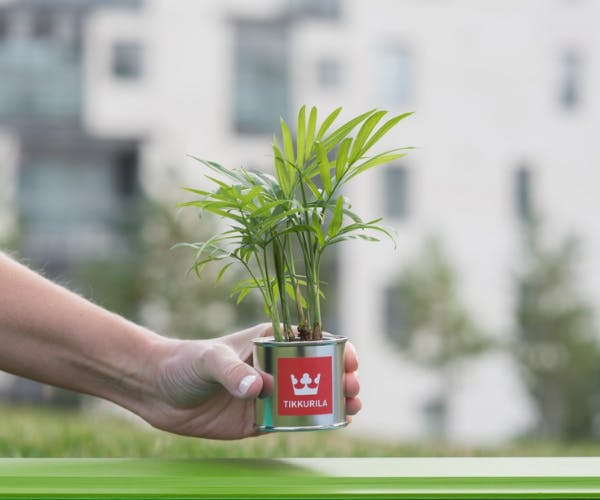Tikkurila’s decorative product range is constantly evolving to utilise new and emerging technology, allowing us to provide best-in-class paint with enhanced levels of safety, quality, functionality, and sustainability.
Optiva Clean Air is the most recent product innovation for 2023. A product designed specifically to combat air pollution and its negative impact on our health. A water-based, stain-resistant, latex paint for walls and ceilings with air-purifying technology that actively reduces the levels of formaldehyde from indoor air, using innovative technology to catch and bind this chemical into the paint film.
Why is this development important?
Research shows that when looking at air pollution, exterior air quality is not our only concern. Indoor air tends to be at least five times more polluted than outdoor air, yet we spend the majority of our time at home.
One substance that makes interior air so toxic is formaldehyde. There are often found in everyday products such as wood furniture, concrete, carpets, blankets, air conditioners, fridges, and other insulation materials.
What is formaldehyde?
Formaldehyde is a strong-smelling chemical that is used in building materials and to produce many household products.
Formaldehydes are carcinogenic and can also cause asthma allergies and trigger other reactions. Some people are very sensitive to formaldehyde whereas others have no reaction to the same level of exposure. For those that do, some reaction types include watery eyes, coughing, wheezing, and skin irritation.
Recommended exposure levels vary from country to country but WHO recommends an exposure limit of 0.08 mg/m3. Irritations may be noticeable above that level. For more information on WHO guidelines on indoor air quality click here.


Technology
This interior paint captures formaldehyde from indoor air and binds it to the paint film using new air purifying technology.
When formaldehyde is present in the air, Optiva Clean Air absorbs it and incorporates it into the dried paint, which is evenly dispersed during application. As a result, formaldehyde levels in the room air are significantly reduced.
New eco-label certificate:
This result had been proven effective under two different independent laboratory testing methods (including Static and Dynamic methods). The most relevant to European guidelines (found under ISO 16000:23) and the measure used for Eurofins approval is Dynamic testing.
The Eurofins product certification is a well-established tool for demonstrating compliance of a product with Europe's low VOC emissions criteria. Optiva Clean Air has been awarded the Eurofins Indoor Air Comfort Gold badge, which is the best assurance that a product meets low product emission requirements. Eurofins Indoor Air Comfort Gold certificates are also directly accepted as proof from sustainable building programmes such as BREEAM.

Key Product Features:
- Contains air purifying technology to improve the indoor air quality by reducing formaldehyde levels
- Offers excellent hiding power (high coverage in fewer coats)
- Premium wet scrub resistance (Class 1) for easy maintenance (can withstand frequent cleaning)
- Tintable to a wide range of colours (and suitable for colour matching)
- Great paint choice for those with allergies
- Zero VOCs
- M1 Approved
- Approved for EU ecolabel and Nordic Swan
- Sustainable choice
- Packaging partly made from recycled plastic
- Full matt finish
Purify your home with Optiva Clean Air

Shop Now
FAQs
Can I wash the walls that have been painted with Clean Air?
You can, indeed. Optiva Clean Air paint has a wet scrub resistance class 1 (according to ISO 13300 testing). Washing has no effect on formaldehyde abatement properties.
Will the formaldehyde captured in the paint film be released back into the environment?
We measured the potential formaldehyde movement back to indoor air after the initial successful 28 day period and discovered that no detectable formaldehyde was released back into the air.
Can I repaint Clean Air with regular paint?
Yes, but it will lose its ability to reduce FA. To maintain FA removal properties, repaint with Clean Air paint. Otherwise, your surface (wall) will again catch FA.
How long will a painted surface remove FA from indoor air?
This is determined by the concentration of FA and the area of painted walls. In more polluted areas, frequent repainting may be required. The repainting interval to maintain protection level can range from 2 to 6 years, depending on calculations and different FA concentrations (30-100 ug/m3).
Can I not just get rid of FA by opening windows?
It depends on where you live, as FA levels can be high even outside. In less polluted areas the answer would be yes, but then when you close the window FA abatement returns to the room.















